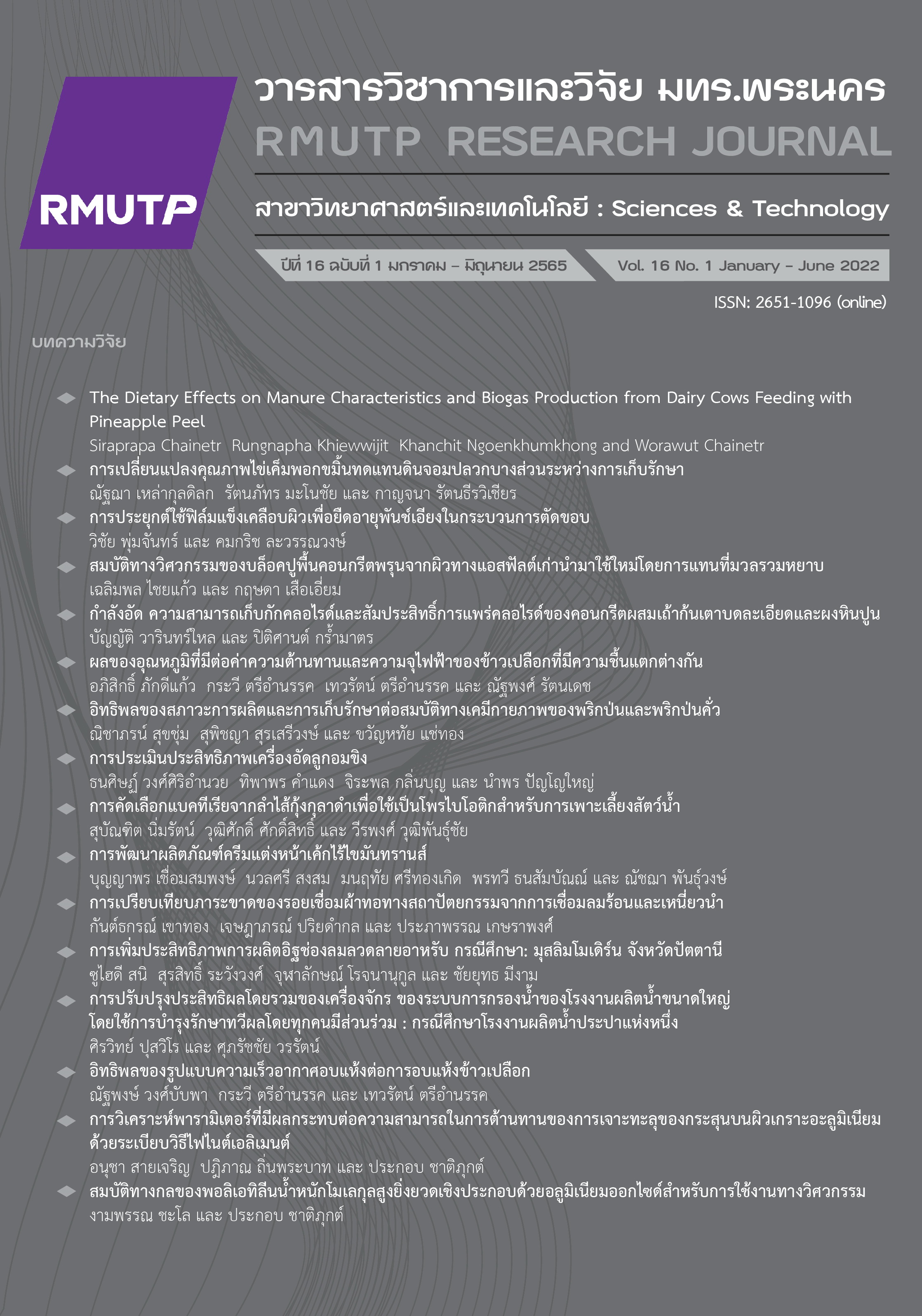สมบัติทางวิศวกรรมของบล็อคปูพื้นคอนกรีตพรุนจากผิวทางแอสฟัลต์เก่านำมาใช้ใหม่โดยการแทนที่มวลรวมหยาบ
Main Article Content
บทคัดย่อ
งานวิจัยนี้มีวัตถุประสงค์เพื่อศึกษาการนำหินที่ได้จากการรื้อผิวทางแอสฟัลต์คอนกรีตเก่าและนำกลับมาใช้ใหม่ในงานบล็อคปูพื้นคอนกรีตพรุน โดยทำการย่อยและแยกขนาดหินด้วยการร่อนผ่านตะแกรงขนาดมาตรฐาน โดยการเลือกใช้ขนาดหินที่ผ่านตะแกรงขนาด 1/2 นิ้ว และค้างบนตะแกรงขนาด 3/8 นิ้ว กับหินที่ผ่านตะแกรงขนาด 3/8 นิ้ว และค้างบนตะแกรงเบอร์ 4 นำมาผสมร่วมกันในสัดส่วนร้อยละ 50 : 50 เพื่อแทนที่มวลรวมหยาบจากธรรมชาติ โดยกำหนดปริมาณปูนซีเมนต์ร้อยละ 18 และ 20 โดยน้ำหนักหิน รวมถึงอัตราส่วนน้ำต่อปูนซีเมนต์เท่ากับ 0.30 และ 0.35 ตามลำดับ ทำการทดสอบกำลังรับแรงอัด กำลังดัดและอัตราการซึมผ่านน้ำ ผลการศึกษาพบว่าปริมาณซีเมนต์เพสต์และอัตราส่วนน้ำต่อปูนซีเมนต์มีอิทธิพลต่อสมบัติด้านกำลังและอัตราการซึมผ่านน้ำของบล็อคปูพื้นคอนกรีตพรุน โดยบล็อคปูพื้นคอนกรีตพรุนที่ผสมร่วมปริมาณปูนซีเมนต์สูงกว่า (ร้อยละ 20) จะมีค่ากำลังอัดที่อายุ 28 วัน เพิ่มขึ้นถึงร้อยละ 16-24 เมื่อเปรียบเทียบกับปริมาณปูนซีเมนต์ต่ำกว่า (ร้อยละ 18) ในทางกลับกันอัตราการซึมผ่านน้ำลดลงร้อยละ 5.1-8.1
Article Details

This work is licensed under a Creative Commons Attribution-NonCommercial-NoDerivatives 4.0 International License.
ลิขสิทธ์ ของมหาวิทยาลัยเทคโนโลยีราชมงคลพระนครReferences
N. H. Abd Halim, H. Md. Nor, R. P. Jaya, A. Mohamed, M. H. W. Ibrahim, N. I. Ramli and F. M. Nazri, “Permeability and Strength of Porous Concrete Paving Blocks at Different Sizes Coarse Aggregate,” Journal of Physics: Conference Series, vol. 1049, 2018.
T. Kamon and T. Ronnakorn, “A Study of Water Permeability on Porous Concrete Using Recycled Coarse Aggregates,” in Proceeding of the 25th National Convention on Civil Engineering, Chonburi, Thailand, 2020, pp. MAT13-1-MAT13-7.
C. Nantachai, “Unit Weight and Compressive Strength of Pervious Concrete mixed with Oil Palm Shell,” Journals of Community Development and life Quality, vol. 1, pp. 97-106, 2013.
V. Sata, A. Wongsa and P. Chindaprasirt, “Properties of Pervious Geopolymer Concrete Using Recycled Aggregate,” Construction and Building Materials, vol. 42, pp. 33-39, 2013.
Y. Hirun, T. Tanchaisawat, P. Mulrungsee, V. Bumlungam and A. Peasura, “The Pervious Concrete Paving Blocks,” in Proceeding of the 4th Annual Concrete Conference, Ubon Ratchathani, Thailand, 2008.
A. H. Nur. Hidayah, Md. Nor. Hasanan and P. J. Ramadhansyah, “Porous Concrete Paving Blocks Using Coarse Aggregate,” Applied Mechanics and Materials, vol. 554, pp. 111-115, 2014.
J. Suebsuk, K. Chaiyadechakorn, P. Panpipat and T. Poongernkham, “Compressive and Splitting Tensile Strengths of Concrete Using Recycled Pavement Waste as Coarse Aggregate,” SWU Engineering Journal, vol. 11, no. 2, pp. 125-132, 2016.
J. Suebsuk, K. Chaiyadechakorn and P. Panpipat, “Mix Design of Portland Cement Concrete using Recycled Asphalt Pavement (RAP) as Coarse Aggregate in Highway Applications,” in Proceeding of the 24th National Convention on Civil Engineering, Udonthani, Thailand, 2019.
N. Saboo, A. N. Prasad, M. Sukhija, M. Chaudhary and A. K. Chandrappa, “Effect of the use of recycled asphalt pavement (RAP) aggregates on the performance of pervious paver blocks (PPB),” Construction and Building Materials, vol. 262, pp. 120581, 2020.
Thai Industrial Standard (TIS) 378-2531, Concrete flooring tiles, Thai Industrial Standards Institute, Ministry of Industry, Bangkok, Thailand, 1988.

